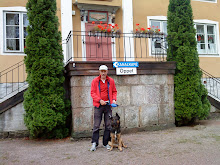This is a challenge for anyone to check and improve overall stamina, not to forget the cardiac stamina.
Farmer's walk part 1
Recommendable to start with: Guys not used to carrying a heavy backpack during a long period of time should undergo a health investigation by their doctor. Don’t forget to bring enough water for the dog.
Farmer's walk Part 2: General
How much weight are you able to carry in your backpack and walk 10 km with it on a forest track? I myself have just done it with 15 kgs in the backpack, on the so called Green track of 10 kms in Hallstahammar, with two large dogs in leash as walking buddies.
The guys trying to get to the top of Mount Everest, as well used by Herzog when his team got to the top called Annapurna, usually hire carriers, sherpas, for taking up the equipment to the various stations. Each sherpa carries 50 kgs in the backpack. It is a terribly heavy load!
I have seen the original Farmer's walk on TV in the program called "The world's strongest man". They carry one weight in each hand, like a heavy suitcase in each hand, and they carry them a relatively short distance. But the weight of each suitcase is so heavy that an ordinary man can absolutely not lift it, walking with them is out of the question. Very strong guys!
It is well known that "walking" burns fat effectively. Adding a heavy backpack will make it even more efficient. Add an appropriate weight easy to carry in each hand. One or two dogs on leash is good for the balance. The distance should be 10-15 kms, to train for the next mountain hike with all the stuff in the backpack. My model shown above is a good deal more fun than power walk, i.e. walking with poles.
Farmer's walk part 3: About weights and where to walk
A common backpack load is about 15 kgs.
Another parameter is to use a smoother or steeper track profile. Various different profiles of the track should be used. The principle of variation increases the stamina more.
A person’s weight can easily be estimated by the Body Mass Index, BMI.
Farmer's walk part 4: Design of Backpacks for outdoor activities
One common special type of backpack (sometimes referred to as a "technical pack" or "frame pack") is designed for backpacking and other outdoors activities. These type of packs are more complex than most other backpacks. Compared to backpacks used for more day-to-day purposes such as schoolbooks, such packs are designed to carry substantially heavier loads, and as a result most such packs attach not only at the shoulders but at the hips, using a padded hip belt to evenly distribute the weight of the pack to the legs and back for better balance and comfort (this is a must for long hikes and extensive trips through trails.) The often heavily padded and sometimes semi-rigid shoulder straps are mainly for balancing the weight. They usually (except for those used in ultralight backpacking) have a metal or plastic frame to support and distribute the weight of the pack. Larger packs of this type tend to have a subdivided main compartment. These trekking packs often have several pockets on the outside; they may also have lash points on the exterior (either directly attached to the frame or webbing loops), so that bulky items may be strapped on, although depending on the pack design and type of trek most backpackers will try to stuff everything into the pack. Multiday packs typically have a content between 60 and 100 liters (and are about 3 ft /1 meter tall). Smaller packs with similar features are available for shorter trips.
My own rucksack is of the make Hiker Vermont 60.
3 år sedan

Inga kommentarer:
Skicka en kommentar